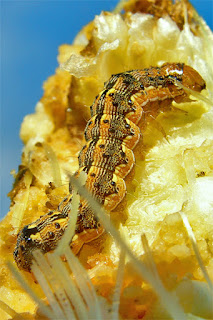A wet late Spring and Summer has been perfect for the growing of corn.
While not really practical from a home garden point of view, it gives kids insights that are more valuable than the resultant crop itself.
Our 3m x 2m plot came to fruition recently and so we began harvest, only to find someone had started the harvest without us.
Known by many names, due to the variety of crops on which it feeds, Helicoverpa armigera ( family Noctuidae), is considered a pest worldwide.
Pics of the the adult moth can be found
here.
The above specimen is considered adult, in its grub stage, being brown in colour, while the specimen below shows its juvenile status by its green colouration.
Despite being considered a pest, the markings of this creature are exquisite.
Im not sure if these millipedes were responsible for this area of consumption, or whether they took advantage of an opening to construct their home.
Much corn was harvested, with much of it still good.
The amount shared with these insects was negligible and the encounter was quite educational.












